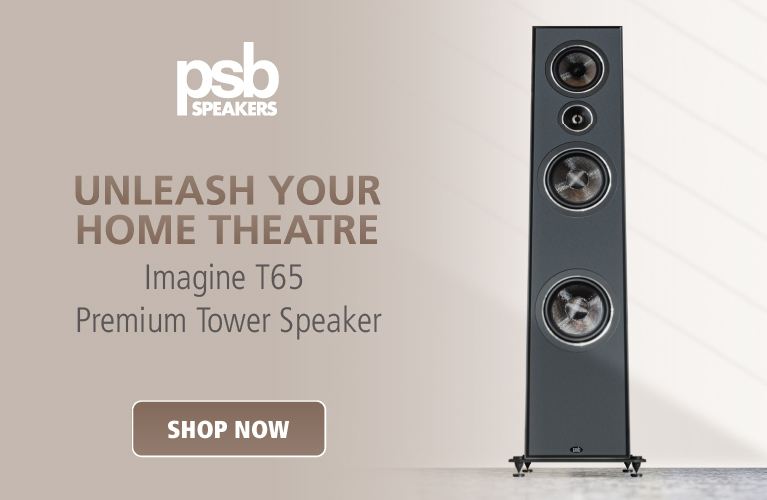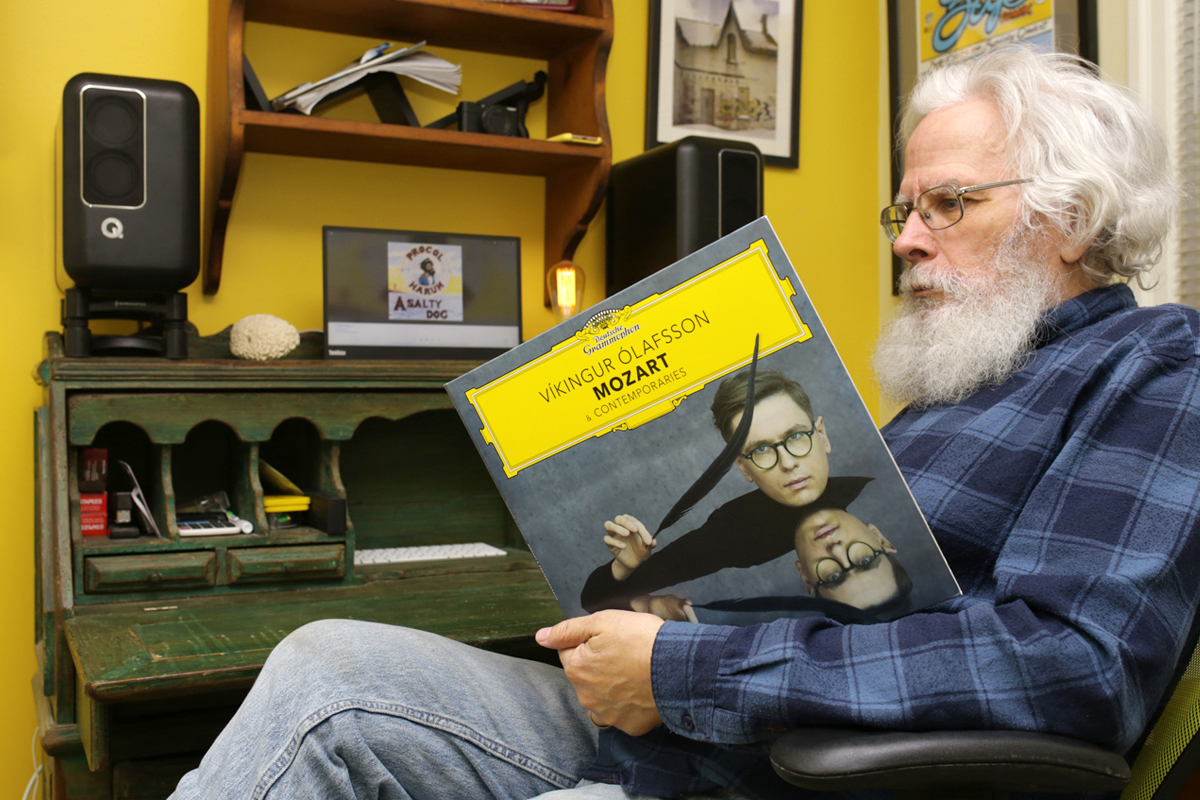There’s a short answer to the question posed by the title of this article: “Of course they do.” I could leave it at that, in which case this would be the shortest article ever published on the SoundStage! Network. A slightly longer answer is that the place of physical media in Simplifi’d hi-fi is declining, just as it is in hi-fi in general. But make no mistake—vinyl and CD are still relevant.
Number crunching
If anybody doubts this, they just have to look at data from music-industry bodies like the International Federation of the Phonographic Industry (IFPI) and the Recording Industry Association of America (RIAA). But raw data can be interpreted in many ways, so let’s have a dig.

According to IFPI’s 2023 Global Music Report, worldwide revenues from streaming in 2022 were $17.5 billion (all figures in USD), up from $15.7 billion in 2021 and $12.7 billion in 2020. Interestingly, revenues from physical media have also been growing, post-pandemic, from $3.8 billion in 2020 to $4.4 billion in 2021 to $4.6 billion in 2022. In 2022, streaming accounted for 67% of global music-industry revenue, and physical media for 18%.
According to the RIAA Mid-Year 2023 Revenue Report, US music-industry revenue from streaming during the first half of 2023 totaled $7 billion, accounting for 84% of total revenue, and up from $6.4 billion in the first half of 2022. But sales of physical media also grew, from $840 million in the first half of 2022 to $882 million in the same period in 2023.
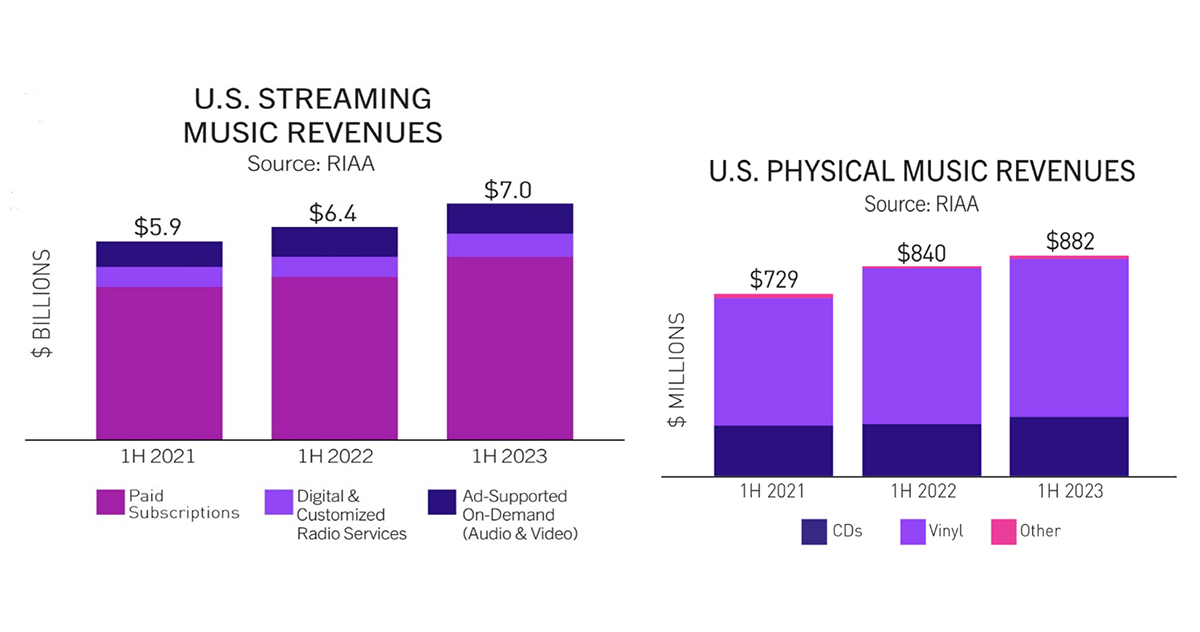
What do these figures tell us about how people are actually listening? Not a whole lot. IFPI and RIAA are industry bodies, and their studies track revenues, not listener behavior. If you naively inferred listening behavior from the IFPI report, you might conclude that, on aggregate, 67% of the music people listened to worldwide in 2022 came from streaming services, and 18% from physical media. Of course, that’s not the case. For one thing, many people listen to LPs and CDs that they’ve purchased over the years, as well as digital files that they’ve downloaded or ripped from their music collections.
These reports don’t even tell us much about how people are getting new music. According to the RIAA report, US music-industry revenues from vinyl sales were about one-tenth the revenues from streaming in the first half of 2023. But LPs are expensive, and streaming is relatively cheap. So the amount of new music people get on vinyl must be a tiny fraction of what they get from streaming.
We’re all outliers
If we want to discuss how physical media fit into Simplifi’d hi-fi, a good place to start is the blurb on the SoundStage! Network portal that describes Simplifi’s mandate: “Equipment reviews and feature articles focused on convenient, lifestyle-oriented hi-fi.” I’ll add a footnote to that statement—Simplifi’d hi-fi systems should fit comfortably into the spaces where people spend their day-to-day lives. In many cases, that requires a system with a smaller footprint than a traditional source-amplifier-speaker setup. Of course, people’s lifestyles vary widely, and so do their ideas of convenience. Simplifi’d hi-fi isn’t a one-size-fits-all pursuit.
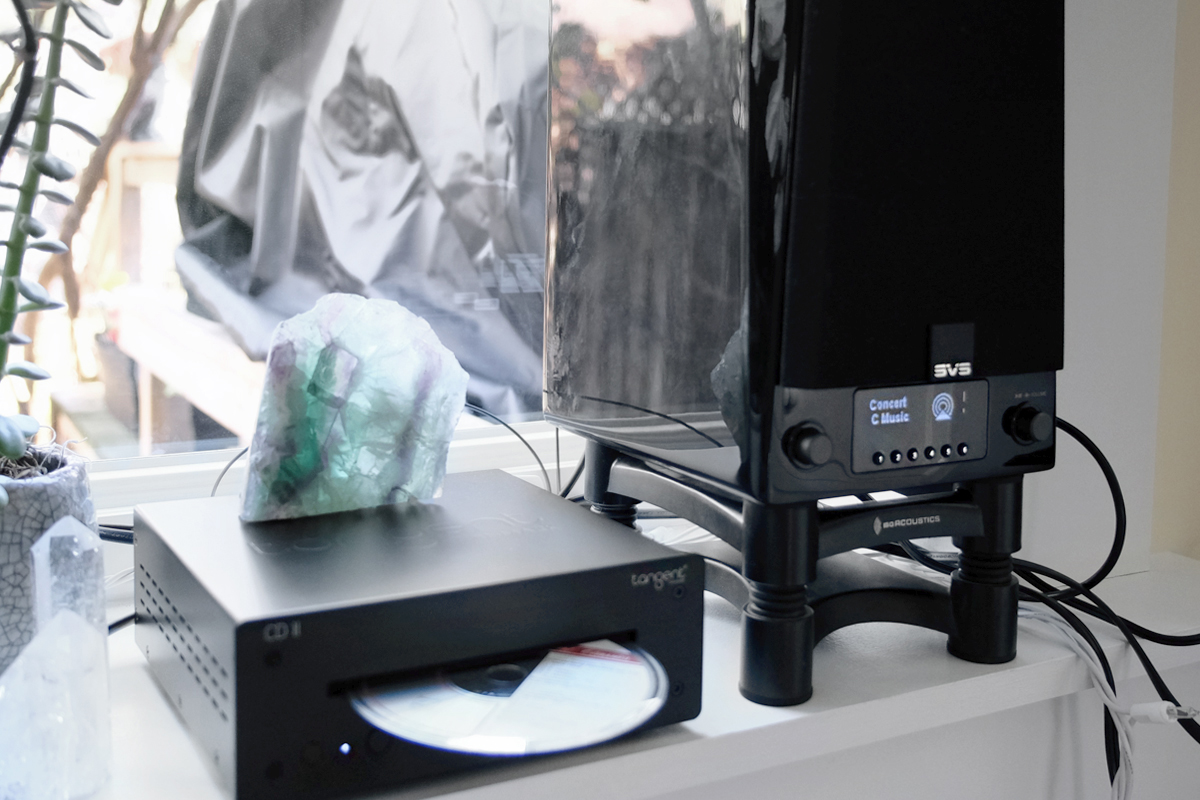
Take my wife’s friend Ursula, for example. She recently got an SVS Prime Wireless Pro active loudspeaker system ($899.99) so she could enjoy music in the combined living/dining room of her Toronto, Canada, home. She’d been using a Bose Wave SoundTouch Music System IV but wanted more powerful sound and deeper bass than that tabletop system could deliver. But Ursula didn’t want to clutter her living space with components. She also wanted to be able to play her large collection of LPs and CDs, which are stored in closed cabinets in the dining area.
The Prime Wireless Pro is an active design. The primary speaker houses four 50W amplifiers, powering the tweeters and midrange-woofers in both enclosures, so Ursula didn’t need an external amplifier. The system has Wi-Fi and Bluetooth connectivity, and a network streamer based on DTS Inc.’s Play-Fi technology. And it supports Apple AirPlay 2 and Spotify Connect.
On the other hand, the Bose Wave system has a built-in CD player. To play CDs, Ursula bought a Tangent CD II CD player, and connected it to the Prime Wireless Pro’s optical S/PDIF input. For vinyl, she already had a 1byone portable turntable that her daughter had given her. That ’table has a built-in phono preamplifier, which the SVS system lacks, so she could connect the turntable’s output to the SVS system’s line-level analog input. Now Ursula could stream, play CDs, and spin LPs on a system that is only slightly more visually intrusive than the Bose Wave system it replaced. But it sounds way better and delivers full-blown stereo. The Bose system has been moved upstairs to the master bedroom.
What’s interesting is the way Ursula ended up using her new system. She plays CDs and LPs, and streams from Apple Music and Spotify. But most of the time, Ursula listens to internet radio. The SVS system’s primary speaker has six pushbuttons that give instant access to preprogrammed playlists and internet radio stations. Ursula’s main musical interest is classical music, especially baroque. I used the Play-Fi app to program six stations—some local, others international—that match her musical tastes. Now, whenever she wants some music, she just pushes one of those preset buttons. A compressed internet radio stream may not be the last word in hi-fi, but it’s hi-fi enough for Ursula—and it sure is convenient. When she wants to play an LP or CD, she can easily do that, too.
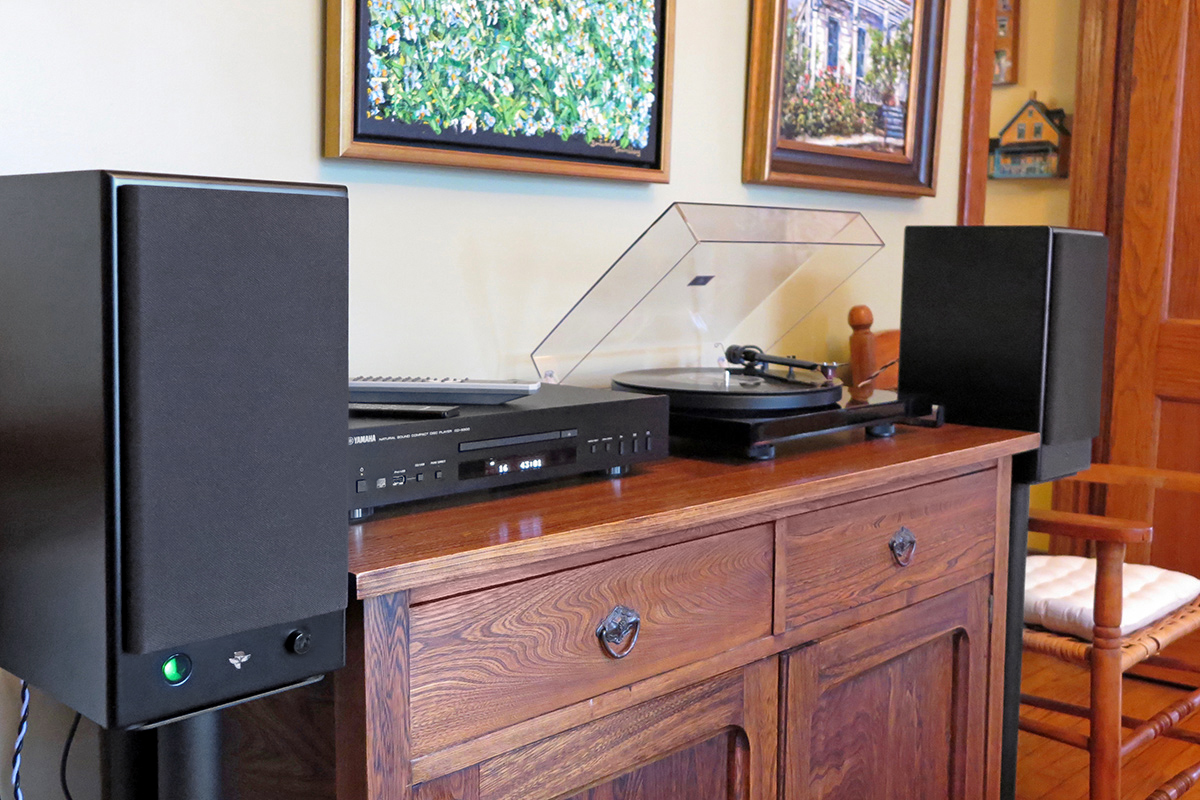
Physical media are much more important for my wife’s sister, Petrea, and her husband, Paul. The system they installed in the dining room of their west-end Toronto apartment reflects that. It’s a beautiful space, but not very large; so, like Ursula, they wanted to minimize component clutter. Petrea and Paul also wanted to play the LPs and CDs they had been collecting since the 1970s, as well as music they had downloaded from Apple’s iTunes store.
When Paul and Petrea came to me for advice on a system, we quickly determined that a powered or active speaker system would be a better bet than passive speakers and a separate amplifier, given their space constraints. A system with AirPlay support would enable them to stream their iTunes downloads to the speakers via Wi-Fi. If they got a Bluetooth turntable, they wouldn’t have to hardwire the ’table to the system. The speakers could sit on bookshelves in the living room, where Petrea and Paul spend more time listening to music, and the turntable could be placed on the sideboard in the dining room. They could round off the setup with a small CD player hardwired to the speaker system.
Petrea and Paul agreed that having speakers with amplification built in was a good idea. But especially for Petrea, this wireless stuff was too unfamiliar, too complicated. What they ended up with was a Totem Acoustic Kin Play powered speaker system ($1299), which has a built-in phono stage; and hardwired to the primary speaker, a Pro-Ject Debut Carbon turntable with Ortofon 2M Red cartridge and a Yamaha CD-S300 CD player. They even use a wired connection to play music from their phones. Simplicity of operation was the paramount consideration for Petrea and Paul, and this system, which is used primarily for LP and CD playback, delivers.
What about streaming? Paul and Petrea don’t stream much. Paul works in television, and as a creative professional, he has scruples about how creators are compensated by streaming services. If he wants an album badly enough, he’ll usually download it from the iTunes store, or purchase an LP or CD.
Yours truly
My listening habits are very different from Ursula’s, and from Paul and Petrea’s, and the gear I use for music playback reflects this. I live with my infinitely better half in a small, urban rowhouse in Toronto’s west end. There’s no dedicated listening room—my primary music system is installed in our main-floor living room. It’s important that the system doesn’t interfere with the other activities that go on in that space. So the only audio components there are the two floorstanding loudspeakers of KEF’s LS60 Wireless system ($6999.99) flanking the electric fireplace.
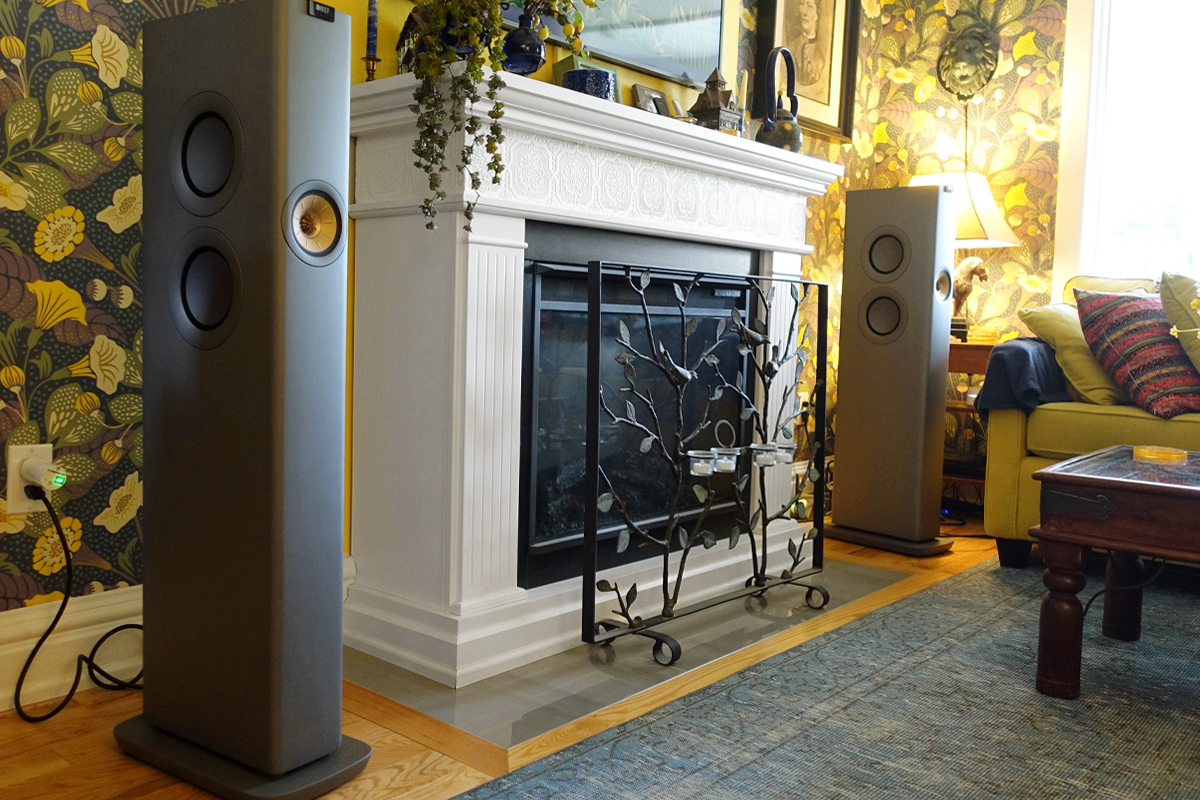
I’d estimate that 74% of the music I listen to is streamed from Qobuz and 24% is ripped and downloaded music stored on a LaCie 2Big RAID array in my second-floor home office. I sold off my LPs in the late 1980s, at the beginning of the CD boom. A couple of decades later, I ripped my CD and SACD collection, and unloaded those discs as well. But lately, I’ve been dabbling with physical media again, and I blame Simplifi for that.
Many of the powered and active speaker systems I’ve reviewed on this site have built-in phono preamps. In 2021, I purchased a Pro-Ject Debut Carbon Evo turntable to evaluate that feature, and rediscovered the joys of collecting and listening to vinyl. While I don’t share Paul’s scruples about streaming, I do enjoy having physical artifacts associated with artists I love. I also appreciate the fact that artists are remunerated more fairly by sales of physical media than by streaming. Since buying my yellow Pro-Ject ’table, I have amassed a modest vinyl collection; I also have some records that belonged to my late parents.
I can’t play these records through the KEF system in the living room—there’s no space there to put a turntable. But I can play them on the desktop music system in my second-floor home office. Until recently, I was using a Q Acoustics Q Active 200 system ($2098) in that space. The two speakers were placed on IsoAcoustics speaker stands on the top shelf of my secretary desk. They received audio from the system’s companion wireless transmitter mounted on the wall just above the shelf where I keep the Pro-Ject ’table. The Q Active Hub has a built-in phono stage, so it was easy to integrate the turntable into my home-office system.
I’ve since changed that setup—now I’m using PSB’s Alpha iQ streaming active loudspeaker system ($1299), and have hardwired the Pro-Ject to the phono input on the primary speaker. I can still spin vinyl in my home office when the mood strikes me—but that’s not very often. Vinyl accounts for 2% of my listening time—at most.
Streaming vinyl
It might account for more if I could play records through my main-floor rig, and recently, I’ve reviewed a couple of turntables that make this possible.
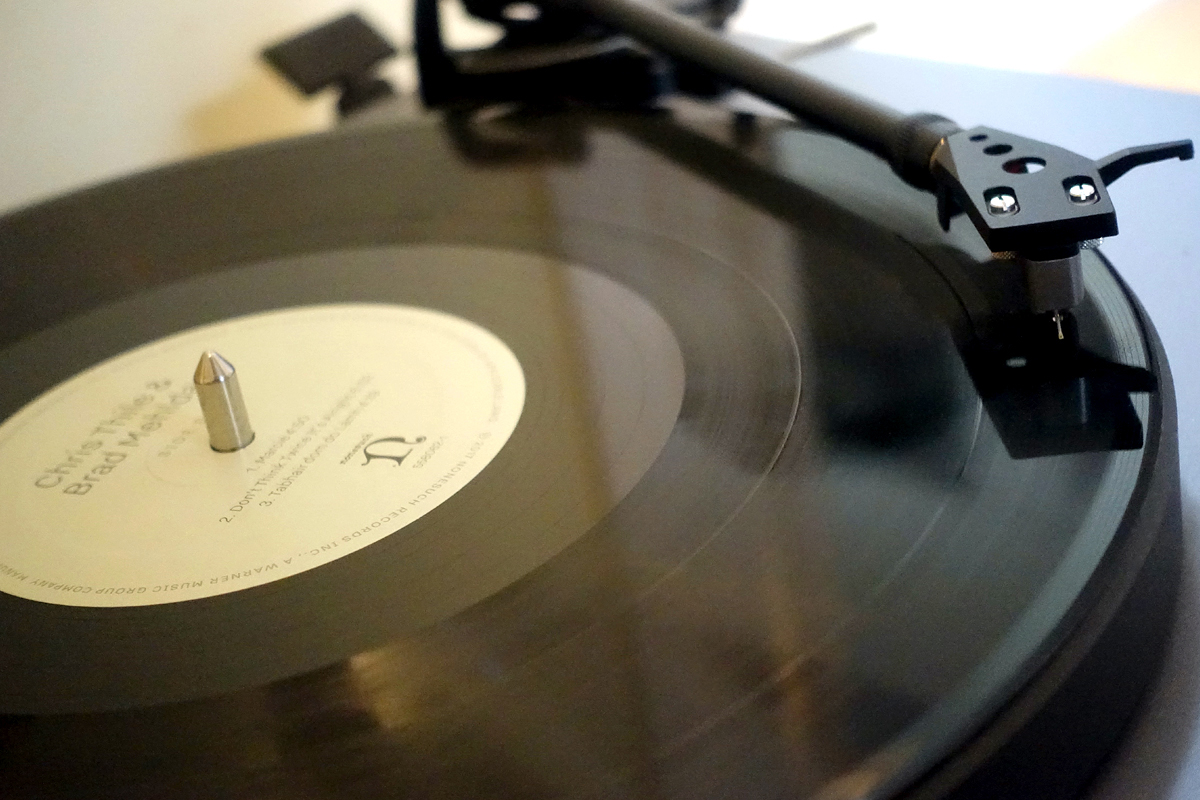
The first was Cambridge Audio’s Alva TT V2 ($1999), which comes with a premounted high-output moving-coil cartridge, a built-in phono preamp, and a Bluetooth transmitter. During the course of that review, I activated the Alva TT’s phono preamp and connected it to the LS60’s analog inputs. I also paired the turntable with the KEF system, which has Bluetooth connectivity. Compared to the wired connection, the Bluetooth stream sounded a little closed-in and homogenized, but it was still very enjoyable. I wasn’t surprised by the differences I heard—Bluetooth audio is compressed, and in this setup, the Cambridge ’table was using the lossy base SBC codec, rather than the higher-resolution aptX or aptX HD codec.
To my knowledge, the Alva TT V2 is the highest-performing and most expensive Bluetooth turntable available. But there are loads of entry-level and mid-market Bluetooth ’tables from brands like Audio-Technica, Pro-Ject, Sony, TEAC, and Victrola. That fact alone confirms that vinyl has a place in Simplifi’d hi-fi.
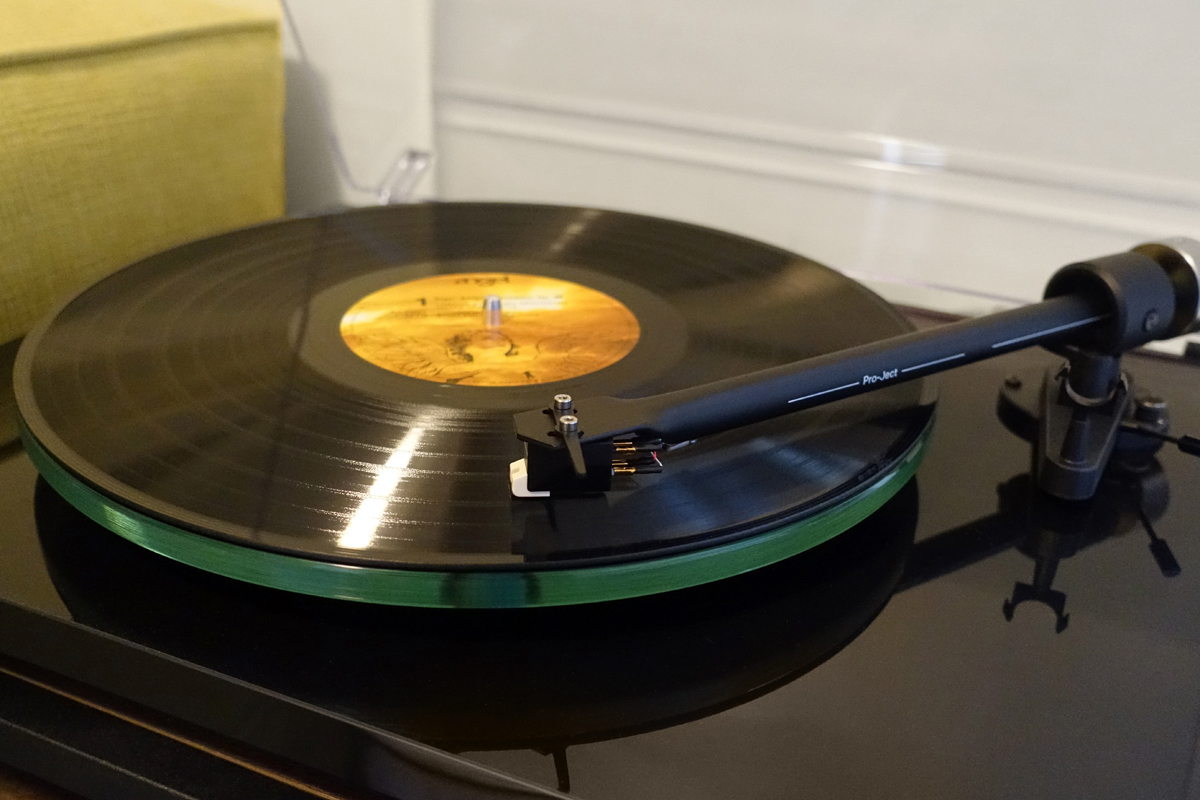
A couple of months later, I reviewed Pro-Ject Audio Systems’ T2 W Wi-Fi turntable ($1199). The T2 W has a built-in phono preamp, and an internal module that streams digitized output from the phono stage via Wi-Fi to devices that support the UPnP protocol. By default, the T2 W transmits compressed 256kbps MP3 audio, but it can stream lossless 16-bit/48kHz FLAC audio to compatible devices. Streaming via Wi-Fi has many advantages over Bluetooth, including greater range, the ability to stream to several devices simultaneously, and—as demonstrated by the T2 W’s 16/48 FLAC output—improved sound quality.
As part of my review, I hardwired the T2 W’s output jacks to the line-in jacks of my KEF LS60 Wireless system, and compared the sound with the 256kbps MP3 stream that the T2 W was sending to the LS60 via Wi-Fi. With the wired connection, the sound was a little smoother and harmonically richer, and the portrayal of space was more convincing. But these differences were only noticeable when making a direct comparison.
In an email exchange, I asked Pro-Ject founder Heinz Lichtenegger if the company was planning to offer higher-end turntables with Wi-Fi streaming. No such products are currently planned, he told me. But Lichtenegger did confirm that an outboard phono stage with Wi-Fi streaming capability is in the works. A Wi-Fi phono stage—I’d be all over a product like that, because it would let me stream audio from my Debut Carbon Evo, or any other turntable, over my Wi-Fi network.
Shiny discs
What about CDs? I don’t know of any CD players that can transmit audio via Wi-Fi or Bluetooth, but there are many players with built-in streamers that can receive audio via Wi-Fi and play it through connected components.
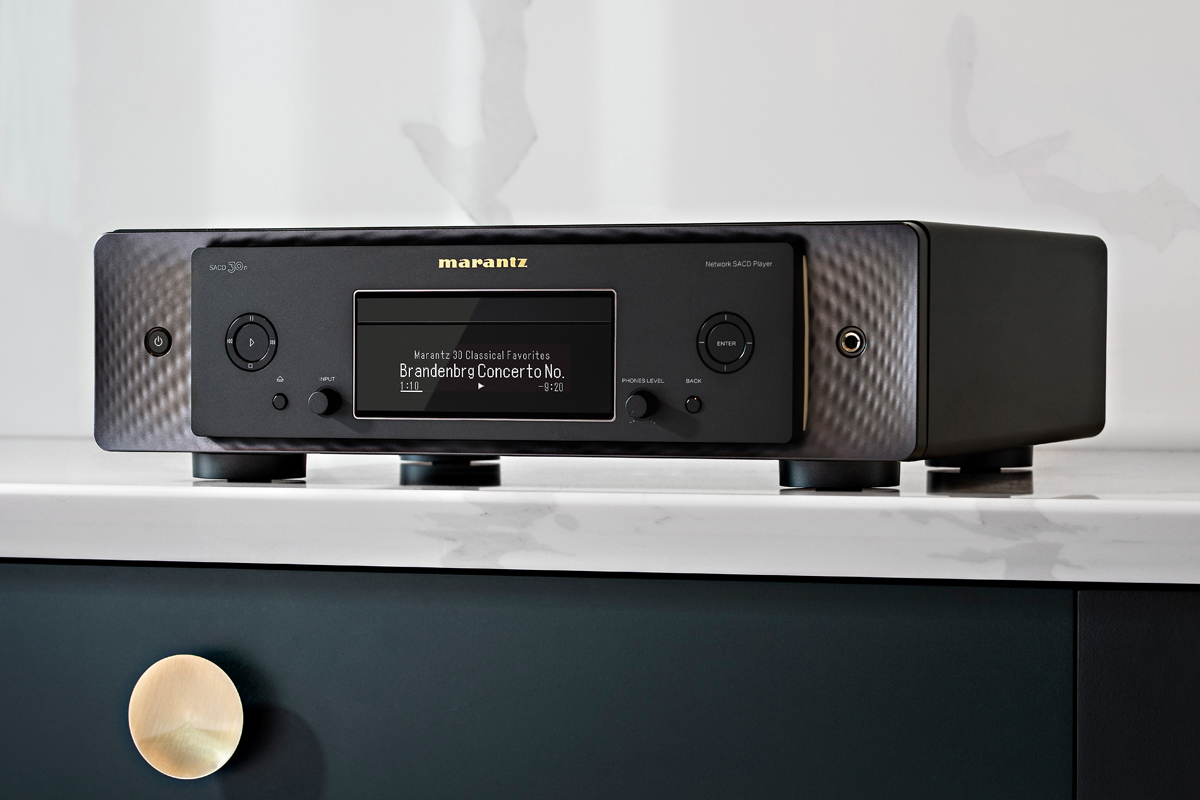
I reviewed one such product in March 2021. The Marantz SACD 30n CD/SACD player ($2999) has a built-in network streamer based on the HEOS platform developed for Marantz and Denon products. The SACD 30n has a broad range of digital inputs as well as fixed and variable line-level outputs. You can connect the fixed-level outputs to a preamp or integrated amp and use the Marantz as a source device, or connect the variable outputs directly to a pair of active speakers and use it as a source device and preamplifier—which is what I did. This versatile component lets you play CDs and SACDs, stream music from online services, and play music from a smartphone or computer.
In October, Marantz announced the CD 50n ($1800), which also has a built-in HEOS streamer, fixed and variable line-level outputs, and a headphone amplifier. Watch for Dennis Burger’s review of the CD 50n on Simplifi in early 2024. Other streaming CD players on the market include the Technics Grand Class SL-G700M2 ($3499.95), which was reviewed by Roger Kanno on SoundStage! Hi-Fi on September 15.
Lots of options
Except for the new Marantz CD 50n and the Technics player reviewed by Roger, I have firsthand experience with all of the components I’ve discussed here. But they’re a small subset of the products that let you stream music from LPs or CDs over your home network. Here are a couple of interesting examples.
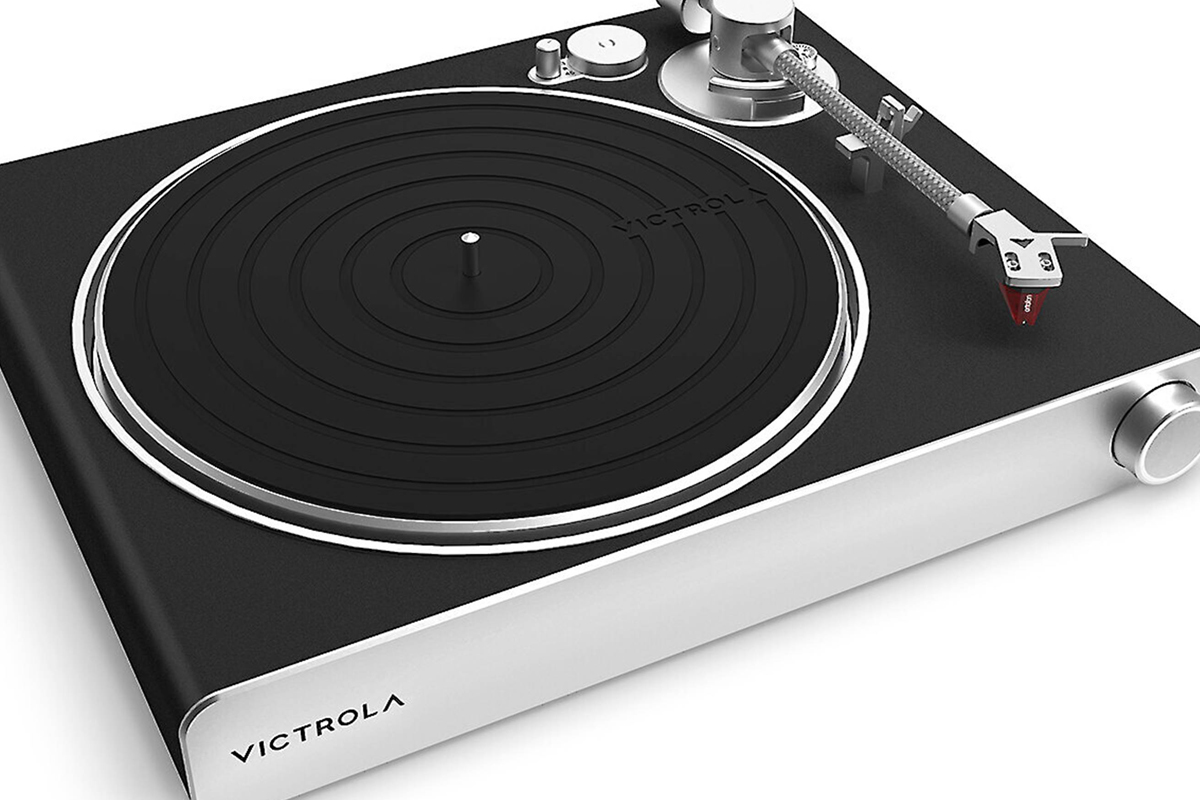
For Sonos users, there’s the Victrola Stream Carbon ($699.99), which can transmit audio via Wi-Fi to any Sonos player. For owners of BluOS-enabled components from Bluesound, NAD, and other brands, there’s the Bluesound Hub ($319), a nifty accessory with phono, optical and coaxial S/PDIF, and HDMI eARC inputs. The Hub can stream audio from any connected component to BluOS-enabled components throughout your home.
Streaming may be the main cash cow for the music industry, and the way most people discover and experience recorded music these days. But physical media are still relevant to Simplifi’d hi-fi, as all these components attest.
. . . Gordon Brockhouse



